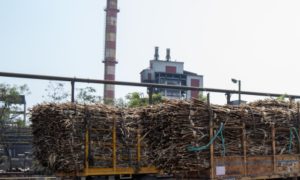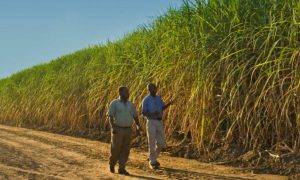Development in sugarcane: Fine-tuning leaf angle with CRISPR improves sugarcane yield

Researchers at the University of Florida have used CRISPR/Cas9 to edit sugarcane genes, improving leaf angles and increasing biomass yield by 18%. Published in Plant Biotechnology Journal, the study highlights the potential of gene editing in overcoming challenges posed by sugarcane’s complex genome. This aligns with the objectives of CABBI to enhance biofuel production. Field trials confirmed that optimized leaf angles led to significant yield improvements without additional fertilizer. This is the first peer-reviewed publication on CRISPR-edited sugarcane field trials.
Sugarcane stands out as the world’s largest crop in terms of biomass yield, contributing to 80 percent of global sugar. Its substantial size and efficient utilization of water and light make it an ideal candidate for producing advanced renewable bioproducts and biofuels.
Yet, due to its complex genome as a hybrid of Saccharum officinarum and Saccharum spontaneum, enhancing sugarcane through traditional breeding methods poses challenges. Consequently, researchers are turning to gene editing tools like the CRISPR/Cas9 system to precisely target sugarcane’s genome for improvement.
In their new paper, published in Plant Biotechnology Journal, a team of researchers from the University of Florida at the Center for Advanced Bioenergy and Bioproducts Innovation (CABBI) has leveraged this genetic complexity to their advantage to use the CRISPR/Cas9 system to fine-tune leaf angle in sugarcane. These genetic tweaks allowed the sugarcane to capture more sunlight, which in turn increased the amount of biomass produced.
This study aligns with the objectives of the DOE-funded CABBI Bioenergy Research Center, which focuses on synthesizing biofuels, bioproducts, and high-value molecules directly in plant stems like sugarcane.
The complexity of the sugarcane genome, characterized by high redundancy with many gene copies, makes CRISPR/Cas9 particularly suitable. By targeting the LIGULELESS1 (LG1) gene, which influences leaf angle, researchers were able to adjust sunlight absorption, crucial for biomass production. Editing various copies of LG1 resulted in different leaf angles, optimizing biomass yield.
Field trials demonstrated that sugarcane with more upright leaves allowed greater light penetration, leading to increased biomass yield. Notably, one sugarcane line with edits in approximately 12% of LG1 copies exhibited a 56% decrease in leaf inclination angle and an 18% increase in dry biomass yield.
These gene edits enhance biomass yield without requiring additional fertilizer, underscoring the importance of understanding complex genetics and genome editing for crop improvement. Moreover, this study represents the first peer-reviewed publication on field trials of CRISPR-edited sugarcane, highlighting opportunities for fine-tuning traits in polyploid crop genomes.
Source Link : https://www.chinimandi.com/development-in-sugarcane-fine-tuning-leaf-angle-with-crispr-improves-sugarcane-yield/














